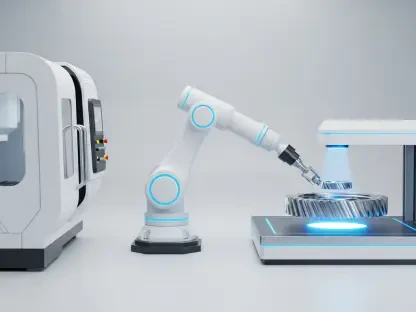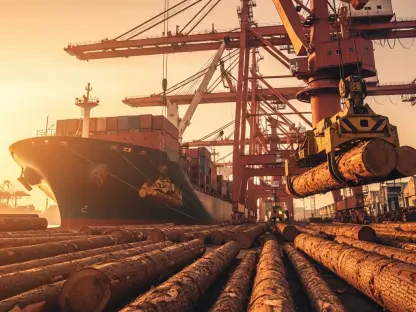The manufacturing and automation industries are witnessing profound transformations driven by advancements in technology, evolving supply chain dynamics, labor market shifts, and global political events. These sectors are on the cusp of major innovations, with future developments poised to redefine how production processes are managed and executed across the globe. In this article, we delve into the critical trends that are shaping the future of manufacturing and automation, exploring the challenges and opportunities that lie ahead.
The Fifth Industrial Revolution in Automotive Manufacturing
The United Kingdom’s automotive production sector is leading the charge in what is being heralded as the fifth industrial revolution (5IR). This new era of manufacturing is defined by the integration of advanced robotics, building on the technological advancements of the fourth industrial revolution (4IR) that began over a decade ago. The introduction of next-generation robotics has enhanced efficiency, precision, and productivity, resulting in a transformative impact on the automotive industry.
The adoption of advanced robotics in automotive manufacturing is not simply about substituting human labor with machines but augmenting the existing workforce’s capabilities. These technologies enable the performance of more intricate and precise tasks, significantly reducing human error and increasing output quality. This transformation allows automotive manufacturers to achieve significant improvements in their production processes, which is pivotal for maintaining competitiveness in an increasingly globalized marketplace.
Furthermore, the shift toward 5IR is driving innovation in auxiliary areas of manufacturing, such as materials science and supply chain management. By leveraging advanced robotics, manufacturers can experiment with new materials and production techniques that were previously unattainable, pushing the boundaries of what is possible within automotive manufacturing. The broader implications of this innovation journey suggest that other manufacturing sectors will eventually adopt similar strategies, further spreading the impact of the fifth industrial revolution.
The Importance of Strong Supply Chains in CNC Manufacturing
Within the scope of CNC (Computer Numerical Control) manufacturing, the significance of robust supply chains cannot be overstated. Effective demand forecasting remains a significant challenge, as inaccuracies can lead to either stock shortages or excess inventory, both of which carry substantial financial risks. Efficient supply chains are crucial for ensuring timely delivery and maintaining production schedules, which, in turn, contribute to overall operational efficiency and cost-effectiveness.
CNC manufacturing processes are intrinsically complex, requiring a supply chain that can adapt to demand and supply fluctuations. Manufacturers today must invest in sophisticated supply chain management systems that leverage data analytics and machine learning to improve demand forecasting accuracy. By adopting advanced technologies, they can minimize the risks associated with inventory management and ensure a steady flow of essential materials and components. This approach not only enhances operational efficiency but also supports sustainable production practices.
Additionally, the integration of digital technologies in supply chain management is enabling greater transparency and collaboration among all stakeholders. Real-time tracking and monitoring tools provide immediate insight into the status of shipments, allowing manufacturers to promptly respond to any disruptions. This capability is critical in maintaining the continuity of operations and reducing downtime, further strengthening the resilience of supply chains in CNC manufacturing.
Cybersecurity: From VPNs to Zero Trust Network Access
As the manufacturing sector becomes increasingly digitized, cybersecurity has emerged as an essential concern that requires immediate and ongoing attention. Traditional Virtual Private Networks (VPNs) are being replaced by Zero Trust Network Access (ZTNA) to enhance security measures and align more closely with the concept of continuous reinvention. This strategic shift is often driven by high-level executive decisions, underscoring the growing awareness of the necessity for innovative and secure business models in the digital age.
ZTNA represents a significant paradigm shift in cybersecurity, moving away from the perimeter-based security model of VPNs towards a more granular approach that verifies every user and device attempting to access the network. By ensuring that only authorized individuals and devices have access to sensitive data and systems, ZTNA significantly reduces the risk of cyberattacks. This approach aligns with broader trends in digital transformation, where businesses are increasingly adopting cloud-based services and remote work models.
The transition to ZTNA is further facilitated by the adoption of cloud technologies, IoT devices, and the increasing need for seamless remote access. Manufacturers can benefit greatly from implementing ZTNA, as it not only secures their digital assets but also provides greater flexibility and scalability for their operations. As the manufacturing landscape continues to evolve, proactive measures in cybersecurity will be crucial for safeguarding intellectual property, operational systems, and overall business integrity.
Addressing Labor Shortages in Manufacturing
Labor shortages are a significant issue facing the manufacturing sector, spurred by reshoring efforts, a wave of retirements, and the evolving skill sets required by new technological advancements. Industry reports indicate that 65% of manufacturers cite attracting and retaining talent as their primary business challenge. To lead U.S. manufacturing into the future, it is essential to develop a robust talent pool, and proactive measures must be adopted today to tackle these workforce challenges effectively.
One effective approach to addressing labor shortages involves significant investments in workforce development programs that focus on upskilling and reskilling current employees. By providing comprehensive training in advanced manufacturing technologies and processes, manufacturers can ensure that their workforce remains adept with the skills needed to thrive in a rapidly changing industry. This investment not only addresses immediate labor shortages but also creates a culture of continuous learning and innovation within the industry.
Moreover, fostering partnerships with educational institutions and industry organizations can play a vital role in bridging the skills gap. Creating clear pathways for students and job seekers through apprenticeships, internships, and vocational training programs can expose them to the latest technologies and provide practical experience. By making manufacturing careers more attractive to the next generation of workers, the industry can build a sustainable talent pipeline to meet future demands.
The Impact of Global Political Events on Manufacturing
The manufacturing and automation industries are undergoing significant transformations driven by cutting-edge technology, evolving supply chain dynamics, shifts in the labor market, and global political events. These sectors are on the brink of substantial innovations that promise to revolutionize production processes worldwide.
Technological advancements such as artificial intelligence, the Internet of Things, and robotics are creating smarter, more efficient factories. These automation tools are not only speeding up production but also enhancing precision and reducing human error. Meanwhile, supply chains are becoming more complex and integrated, requiring companies to adopt more sophisticated logistics and inventory management systems. This shift is further compounded by labor market changes, including skill shortages and the growing demand for a highly specialized workforce.
Current global political events also play a critical role in shaping the future of these industries. Trade policies, tariffs, and international relations can directly impact the availability of raw materials and components, influencing production timelines and costs. As companies navigate these complexities, they must also consider sustainability and environmental impacts, adopting greener practices to meet regulatory requirements and consumer expectations.
In this article, we explore these influential trends, examine the challenges and opportunities ahead, and consider how the manufacturing and automation industries will evolve in response to these dynamic factors.









